Table 2.
Multilevel factors influencing dietary behaviors among older Filipino American participants with cardiovascular disease
| Theme | Participant Quotes and/or Photographs Illustrating Theme | |
|---|---|---|
| Community-level Factors: Socio-Cultural Context | ||
|
Importance of traditional foods to Filipino cultural identity Participants expressed a desire maintain their connection with Filipino culture including modifying rather than abandoning Filipino recipes. |
 Male participant with his photo of Manila Oriental Market: “I shop, at the Filipino Market because we are all Pinoy (Filipino). We are loyal to our food.” |
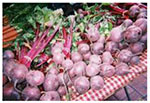 Female participant presenting her photo from the farmer’s market: “I also eat our food crops. But the ones they have here, we don’t eat them in the Philippines. But I got acquainted with them and now I eat them.” |
|
Cultural influences on health beliefs Cultural perspectives shaped health beliefs about food. |
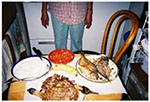 Male participant speaking about why this photograph is significant to him: “Because this food is good for the body. First of all, if fish is what we would eat, it’s easy to dissolve. Even a long time ago, my grandfather had long life because they always ate fish.” |
|
| Household-level Factors | ||
|
Balancing household members’ dietary preferences that conflict with a heart healthy diet Participants trying to adhere to a heart healthy diet described tension in resisting foods preferred by household members |
A male participant speaking of eating with his housemates who prefer a diet with more meat: “In a day, I only try a little of what they eat, just a bit.” A female participant speaking of influences to food preparation in her household: “When it’s like that I have in mind, I have to buy what he wants. I would say that for me, I’ll just have fruits, my apples, carrots, beets, whatever fruits are at home. I can eat them right away. As for him, when he sees something on the table, ay, you’ll see, his brows meet.” |
|
| Physical Environment | ||
|
Constraints of living environment and financial resources Meals prepared by participants were influenced by financial constraints and housing environment and shaped by food distribution assistance. |
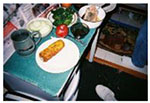 A female participant speaking of the corn, cucumbers, apple and broccoli in this photo that is a typical meal: “This is usually what we eat from the food bank. Whatever comes around, that’s what we do.” The fish is purchased separately and often is not affordable. |
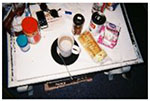 A male participant presenting this photo depicting his breakfast: “So this is what I usually eat in the morning ever since I went solo in 2003…Then I don’t even think of cooking in the morning. There is no kitchen where I live, only a microwave, refrigerator, no stove. It’s actually forbidden. Before, it’s okay until you’re caught, you’ll be given a warning. When you get caught again, you’re out of the house. So this is what seems to be my new habit now.” |
| Interpersonal-level Factors: Healthcare Interactions | ||
|
Physician influence on changes in CVD health behaviors Participants often cited their physician’s advice in modifying their dietary practices. |
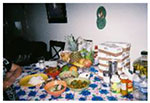 A female participant’s photograph of meal time in her household showing several traditional Filipino dishes (likely chicken tinola in the orange bowl, ginisang ampalay which is sautéed bitter melon in the farther green bowl, and pinakbet which is mixed vegetables steamed in fish sauce) enjoyed family style with a portion of rice for one individual. |
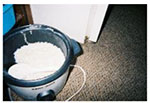 A male participant sharing a photo he has selected: “Rice is a staple food in the Philippines. Although rice is very important, I don’t eat rice as often. Because it is something with carbohydrates. Not every day and when I do eat, only one cup. I don’t want too much of it because the doctor said it is this with carbohydrates. I know that I have diabetes and high blood pressure…that’s really bad. I’m recuperating but then I eat not too much rice.” |
| Individual-level Beliefs and Attitudes | ||
|
Beliefs that traditional dietary practices increase risk of CVD Participants often attributed their health problems to the Filipino diet and eating habits. |
A female participant speaking of having a stroke and learning she had diabetes: “Yes, I cut down on everything. Almost everything is forbidden. Rice is given to you in a cup only… Then salt. I cut back on that too. Plus food that taste good. Sweets, dessert. We would go to parties, they have custard. I just look at it… I miss it, food like that.” A male participant speaking about his diet after receiving hypertension diagnosis: “Potato chips, corn chips, Garlic Boy, pork crackling… I really had no control then. So, when I had high blood [pressure] I removed them slowly, but it was hard, especially when we had… parties. We ate, I got tempted to eat shrimp paste. There was kare-kare (oxtail in peanut sauce) there. Isn’t that delicious? Yes.” Female participant speaking of dietary behaviors and her diagnosis of hypertension: “Number one is salty. I had a sister-in-law, she was always being rushed to the hospital because her heart is floating on water. So they said not to eat salty food. That is what she died of. She couldn’t stop herself from eating salty food. She uses fish sauce, soy sauce.” |
|
